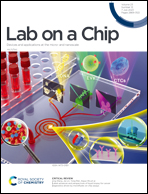Manufactured tissue-to-tissue barrier chip for modeling the human blood–brain barrier and regulation of cellular trafficking†
Abstract
Microphysiological system or organ-on-a-chip technologies can replicate the key structure and function of 3D human tissues with higher reproducibility than less controllable 3D cell aggregate models, providing great potential to become advanced drug toxicity and efficacy test platforms alternative to animal models. However, these organ chip models remain to be manufactured and standardized in a highly reproducible manner for reliable drug screening and mechanism of action research. Herein, we present a manufactured form of ‘micro-engineered physiological system-tissue barrier chip’ called MEPS-TBC for the highly replicable modeling of the human blood–brain barrier (BBB) with a 3D perivascular space. The perivascular region was controlled by tunable aspiration, where human astrocytes reside in 3D, create a network, and communicate with human pericytes facing human vascular endothelial cells, thereby replicating the 3D BBB. The lower channel structure of MEPS-TBC was designed and optimized using a computational simulation to facilitate aspiration while maintaining multicellular construction. Our human BBB model of the 3D perivascular unit and the endothelium perfused by physiological shear stress secured significantly enhanced barrier function exhibiting greater TEER and lower permeability, compared to the only endothelial model, indicating that the cellular interactions between BBB cells significantly contribute to the BBB formation. Importantly, our BBB model showed the cellular barrier function for homeostatic trafficking regulation against inflammatory peripheral immune cells, as well as for molecular transport control across the BBB. We believe our manufactured chip technology will construct reliable and standardized organ-chip models for disease mechanism research and predictive drug screening.



 Please wait while we load your content...
Please wait while we load your content...